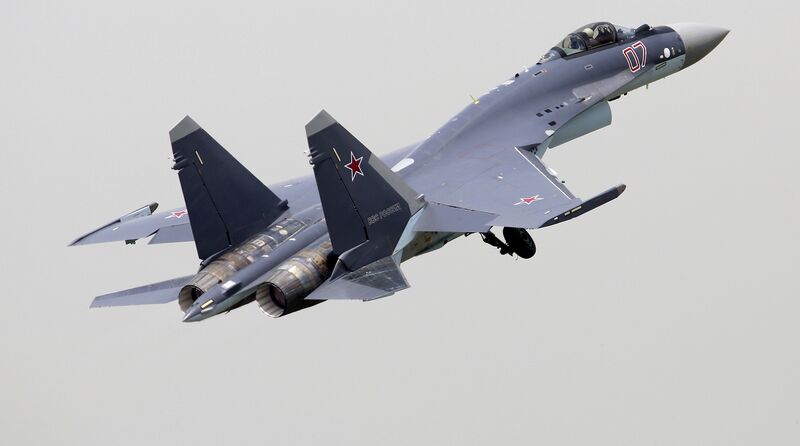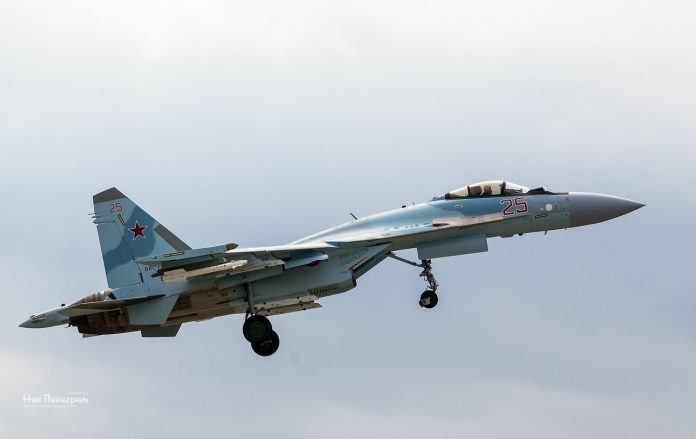U.A.E. to Build Russian Warplane as Mideast Tensions Rise
- Plans concerns successor to MiG-29 light fighter, Rostec says
- Gulf state agrees to procure latest Sukhoi model in interim
The United Arab Emirates signed an outline agreement to buy Sukhoi Su-35 warplanes and will work with Russia to develop a next-generation fighter that could enter service in seven or eight years, according to Moscow-based industrial conglomerate Rostec Corp.
While the latest version of the Sukhoi jet, based on the Su-27 Flanker and previously exported to China, would satisfy the Gulf state’s more immediate requirements, the proposed future model would essentially be “a brand new fighter,” Rostec Chief Executive Officer Sergey Chemezov said Monday.
Though most likely based on the Mikoyan MiG-29, a light warplane known as the Fulcrum in the West, the aircraft would be “highly technological” and feature modern engines, avionics and weapons, Chemezov said at the IDEX defense expo in Abu Dhabi, the U.A.E. capital. Work could start in 2018, he said.
Iran’s resurgence as a regional power following last year’s nuclear deal with the U.S. is spurring military spending in the Middle East after budgets stuttered following the oil-price slump. Countries included Saudi Arabia and the U.A.E. are already engaged in aerial strikes against Tehran-backed Yemen and are likely to switch the focus of spending to more-offensive programs, a study by defense and security specialist IHS Jane’s said last week.
The future fighter proposed by Russia would be built in the U.A.E. “full cycle” following completion of design work and the production of test aircraft, according to Chemezov, a close ally of President Vladimir Putin.
Fifth-Generation Jet
The two-engine, single-seat MiG-29 was developed as an air-superiority fighter to counter U.S. aircraft including the F-15 Eagle and F-16 Fighting Falcon.
Lockheed Martin Corp. F-35 Lightning II and F-22 Raptor, though it’s not clear if it would boast the same stealth capabilities. The agreement parallels one between Russia and India on developing a new-generation fighter, Chemezov said. That deal was held up for several years before being revived in 2016.
Rostec and Russia’s defense manufacturers are also targeting business in Kuwait, Bahrain, Saudi Arabia and Qatar, though cooperation isn’t as advanced as it is with the U.A.E., Chemezov said, adding that the Mideast is attractive as a “market with money in it, and good paying ability.”
Further bolstering ties, Rostec said separately that the Kremlin-backed Russian Direct Investment Fund has formed a consortium of Middle Eastern interests to purchase a 12 percent stake in
Russian Helicopters for an initial investment of $300 million. That could potentially increase to $600 million.
Precision Missiles
The report from IHS Jane’s suggests that Mideast states will take steps to enhance the attacking abilities of their warplane fleets, investing in precision air-to-ground missiles, advanced guidance systems and air-to-air refueling gear that extends the duration of flights.
Combined budgets for the region are likely to reach $180 billion a year by 2020, Jane’s forecasts, predicting that the U.A.E. and Saudi Arabia -- which has a fleet of Panavia Tornado ground-attack aircraft and 72 modern Eurofighter Typhoon fighters ordered from BAE Systems Plc -- will “start to spend heavily” as the potential threat from Iran increases.
European missile maker MBDA is seeing increased interest in precision weaponry, it said at IDEX, as the International Defence Exhibition is known. The venture between BAE,
Airbus Group SE and
Leonardo SpA is pursuing $2 billion of orders in the Mideast that it hopes to secure this year, about half the global total, Florent Duleux, the company’s vice president for the region, said in an interview.
Chemezov said that Rostec is also ready to supply defensive weaponry to Iran if approached, having provided the Islamic republic with S300 surface-to-air missile systems worth $1 billion last year.
Boeing Co. said separately at IDEX that it aims to finalize Mideast deals for existing fighter models with the U.S. government and the buyers in coming months. Dennis Swanson, the company’s vice president for global defense marketing, said the sale of F-15s to Qatar and F/A-18 Super Hornets to Kuwait will be an “important part” of sustaining production lines.
The contracts for as many as 72 F-15s and up to 32 F/A-18Es and eight F/A-18Fs could be
worth as much as $31.1 billion, including through-life servicing and parts.
https://www.bloomberg.com/news/arti...sian-warplane-as-iran-stokes-mideast-tensions













